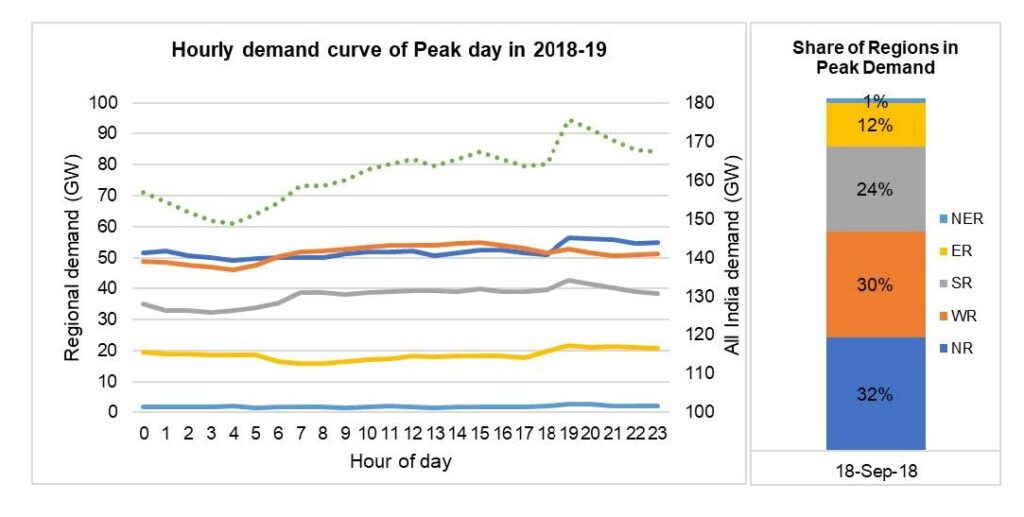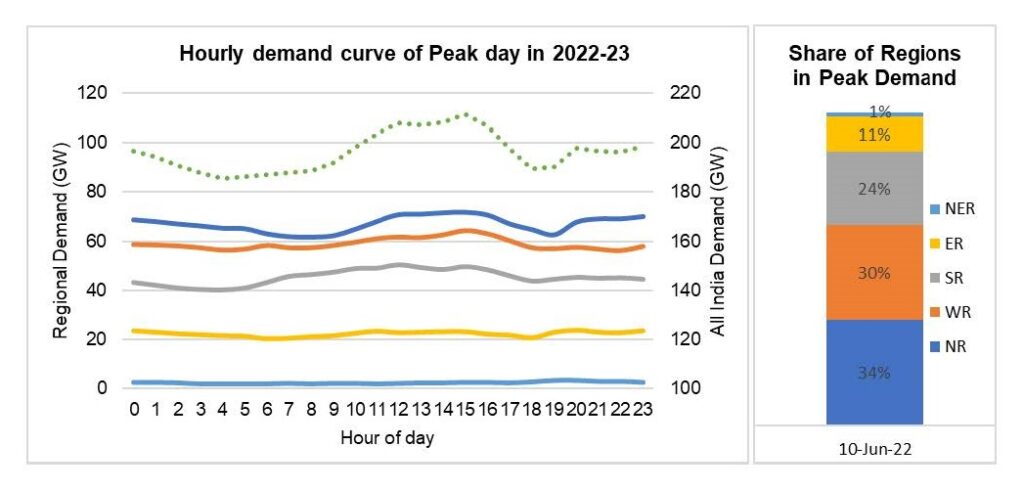- Raghav Pachouri, Shubham Thakre, Sonam Sinha

In Part 1 of this series, we discussed the changes in monthly and yearly electricity peak demand patterns, the increasing variability in demand over the years, and the occurrence of peak demand within the day i.e., hour/time of peaking of electricity demand. In this article we look at the contribution of the five regional grids, that is, the Northern Region (NR), Western Region (WR), Eastern Region (ER), Southern Region (SR), and North-Eastern Region (NER) grids, in the national peak demand. We also try to gain insights from the changing nature of certain demand sectors in few regions.
First, let’s assess electricity consumption and peak demand across the grid regions. As shown in Figure 1, the electricity demand and peak electricity demand shares across the regions from FY2012 to FY2022 has been constant throughout except for a few percentages’ points difference in NR and SR regions. A positive correlation between peak demand share and overall demand share can also be observed from Figure 1. In the last decade, the NR and WR have contributed significantly to the national peak approximately 65%, due to their corresponding larger share in overall demand in these regions. The NR grid’s share in peak demand is higher than its share in overall electricity demand. A significant proportion of electricity demand in the NR grid is by residential consumers, while in the WR grid is by industrial consumers. The significantly greater variance in peak demand in the NR grid can thus be attributed to the impact of the heat wave and the post-Covid growth in residential consumption in FY2022. Between 2015 and 2021, the residential sector registered the fastest growth in the NR grid, at an annual growth rate of 6.8%, against the 6.2% growth rate of the industrial sector in the WR grid during the same period. With an annual growth of 8.5%, the NR grid also registered the highest growth in peak demand over the last 10 years, followed by the NER grid at 6.5%, though its marginal contribution to peak demand was less significant.

Change in regional daily demand patterns
In the current fiscal year, the peak demand of 212 GW occurred on 10th June 2022. A very different demand pattern was observed on this day (when the peak occurred during the day) as compared to previous years, when the peak demand would occur in the evening. As discussed in the next subsection, the rising cooling needs results in a surge in electricity demand, though this peak now occurs during the day. From Figure 2 it can be seen that the regional contribution in the national peak was dominated by the NR. The WR and SR grids too witnessed the peaking of electricity requirements during the day time on 10th Jun 2022. Ideally, renewable energy (especially solar) could aid in absorbing this day time peak- however, it is too early to predict future demand patterns.
To validate the above hypothesis, we compared two peak days- one in September 2018 and the other in June 2022 (see Figure 2). These two events were selected to analyse the impact of regional contribution to the changing peak pattern. While peak demand occurred during the evening in September 2018, it occurred during the day in June 2022. Major changes can be seen in the NR, SR, and ER demand patterns. The peak demand in NR, which would previously occur late in the evening, now occurs in both the afternoon and in the late evening. As NR is more of a residential load centre, the change in demand pattern can be attributed to the cooling need in the residential and commercial buildings during the day time of a hot summer day. The similar change of pattern could be observed in SR and ER regional demand.



Is the Residential and Services demand contributing to daytime peak?
In the previous sub-sections, we discussed the significant contribution of residential demand towards overall peak demand and how the trend is shifting towards daytime. If this is so, which are the sectors contributing towards daytime peak? In NR and SR, residential demand grew fastest between 2015 and 2022 at 6.8% and 5.8% respectively, registering a higher growth than the GDP growth during this time. India’s residential cooling demand is expected to increase exponentially, both due to economic growth linked rising household consumption expenditure, and in order to adapt to climate change. As per a meta-study[1] of developing economies, a 100 Cooling Degree Day (CDD) rise would result in an increase of 3-7% of air conditioning penetration in households across a majority of income classes. As NR is highly vulnerable to extreme heatwaves, air conditioning needs in this region in particular would substantially contribute to increased peak demand, increasingly during the day and for longer durations.
The services sector’s electricity demand is highly elastic to its sectoral value added. Between 2015 and 2022, NR, WR and SR reached a 3.3%, 3.4% and 9% electricity demand growth respectively in the services sector which was faster than the real gross value added during the same time. Although the Electricity Intensity of the sector reduced from 2.7 to 2.2 kWh/Rs 1000 (Real prices) between 2000 and 2021, the share of air-conditioned floor space in commercial buildings increased rapidly and is expected to reach ~30% by 2030 from the current share of ~11%. It is this contributing fact that the regions mentioned above are contributing more towards daytime peak. With the post-Covid economic recovery, it would be interesting to see how the growth in retail, financial and Information technology services might contribute towards both electricity consumption and peak demand.
At this juncture we conclude by mentioning that the share of peak demand varies across regions and has shown changing spatial and temporal trends over the years. As India becomes a more service-intensive economy, and emerges strongly from the Covid pandemic, residential and commercial activities will pick up faster, making managing the peak demand an ever-increasing challenge. In Part 3 of this series, we will take this discussion further and talk about the current and future measures for peak demand management.
[1] https://www.nature.com/articles/s41467-021-26592-2




